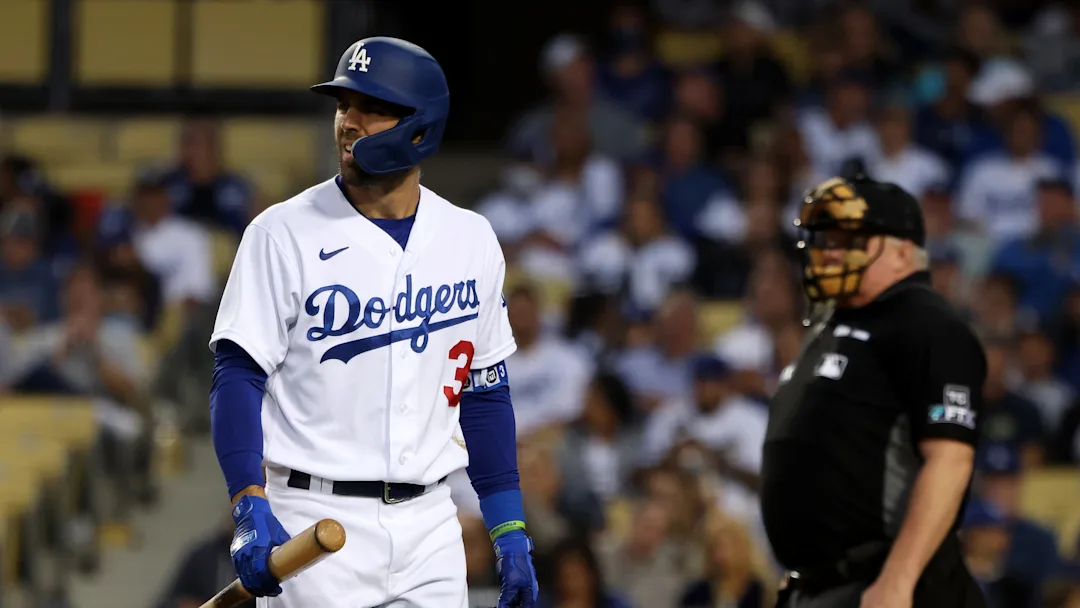The terrible service time scenario with Chris Taylor’s DFA cannot be attributed to the Dodgers.
The situation surrounding Chris Taylor’s Designated for Assignment (DFA) by the Los Angeles Dodgers can be viewed as a culmination of several complex factors, none of which seem to point squarely at the Dodgers’ organizational decisions. Rather, it is a convergence of timing, performance, and circumstance that defines Taylor’s journey. This scenario is far from an easy conclusion, as it underscores the difficulties baseball teams face when trying to balance talent, contracts, and team dynamics. When trying to untangle why a player like Taylor, with his versatility and service to the team, found himself on the receiving end of a DFA, it’s important to explore the elements at play beyond simply attributing blame to the Dodgers’ management.
Chris Taylor’s time with the Dodgers has been largely characterized by his adaptability and strong performance in critical moments. Since joining the Dodgers in 2016, Taylor quickly established himself as a fan favorite for his work ethic and contributions to the team’s success. Primarily known for his versatility in the field, Taylor could play almost every position, allowing the Dodgers to slot him in as a utility player. He became an essential piece in the team’s championship run, particularly during the 2020 season, where his bat and glove helped the team secure the World Series title.
For the Dodgers, Taylor provided stability, especially when injuries or slumps occurred. His ability to handle pressure, combined with a decent bat, made him an ideal player for Los Angeles’ roster. His value was not just statistical; he represented the kind of player that modern baseball teams needed — someone who could plug multiple gaps and who wasn’t strictly limited to one role. Taylor’s versatility was the type of tool that made him more than just a utility player; he became a potential everyday contributor in varying roles.
When examining the reasons behind Chris Taylor’s DFA, it is crucial to understand the nature of the Dodgers’ roster construction during the period leading up to his designation. In major league baseball, rosters are constantly evolving, and the needs of a team shift dramatically over time. In the case of Taylor, the Dodgers’ roster had grown increasingly crowded, especially as new players emerged, injuries healed, and prospects began to push for spots. This natural roster churn often results in difficult decisions, and the timing of Taylor’s DFA likely stemmed from the intersection of several of these factors.
One of the primary elements contributing to his DFA was the Dodgers’ newfound depth, both offensively and defensively. The team’s roster was filled with highly talented players who provided similar versatility and skill sets, which made Taylor’s contributions somewhat redundant. The emergence of younger players and the continuing evolution of the team meant that the Dodgers were faced with the necessity of trimming down players who, despite their history and talent, no longer fit the team’s immediate goals. As new players like Mookie Betts, Freddie Freeman, and other high-impact additions brought even more talent to the team, Taylor found himself squeezed out.
Furthermore, the nature of Taylor’s contract also played a part in his DFA. With a player like Taylor, who had been with the team for several years and had seen his contract grow in value, the financial aspect couldn’t be ignored. The Dodgers, as one of the most well-funded franchises in Major League Baseball, could afford to make such moves, but they also needed to prioritize players with higher upside or more immediate value to the team. A DFA in this scenario, while unfortunate for Taylor, is a business decision that reflects the realities of roster management in a sport defined by its unpredictability.
Another significant reason for Taylor’s DFA was his decline in performance, which became evident in recent seasons. While Taylor had been a key contributor to the Dodgers’ successes, his overall performance began to dip after his strong peak years. Injuries, which have plagued many players throughout their careers, also began to take their toll on Taylor’s output. His hitting, which had been a strength early in his tenure with the Dodgers, became inconsistent. His ability to contribute offensively in critical moments diminished, and his production at the plate declined sharply in 2023.
Injuries, whether minor or significant, can have an outsized impact on a player’s ability to maintain their performance. For Taylor, a player with such a multifaceted skill set, injuries disrupted his rhythm and limited his ability to contribute in multiple ways. Even though he could still contribute defensively, his offensive struggles made it harder for the Dodgers to justify keeping him on the roster when there were younger, healthier players who could provide better overall value.
Baseball has evolved significantly in recent years, and roster management now leans heavily on flexibility. Teams look for players who can not only perform but who can do so in various capacities. Taylor’s versatility made him an ideal candidate for this type of environment early in his career, but as the Dodgers have assembled a more dynamic and deeper roster, the need for such a “jack-of-all-trades” player has diminished. With a focus on having established regulars in the lineup, the Dodgers may have viewed Taylor’s role as expendable in the grand scheme of their team construction.
It’s worth noting that the rise of specialized roles in the modern MLB is also part of the reason for Taylor’s departure. Baseball has increasingly moved towards more defined roles, with organizations often preferring players who can excel in one area over those who can handle multiple positions but may lack elite skills in one. With the Dodgers’ roster brimming with specialists, Taylor’s ability to do a bit of everything may have been less valuable than it once was.
While it’s easy to attribute Taylor’s DFA to the Dodgers as a failure of decision-making, this situation is more about timing and circumstance than a glaring mistake by the team. Baseball, like any other sport, is about adapting to changing realities, and the Dodgers have been forced to make difficult decisions in order to stay competitive. It’s not uncommon for organizations to part ways with players who have given so much to the team, particularly when their contributions no longer align with the team’s needs or when the player’s performance dips due to age or injury.
Moreover, the Dodgers are far from a team that makes decisions lightly. They have one of the most successful front offices in baseball, known for their strategic acumen and long-term vision. Any move they make is typically well thought out, considering both the immediate and long-term implications for the roster. In Taylor’s case, while the DFA may seem harsh given his history with the team, it is likely that the Dodgers were simply prioritizing what was best for the current state of the team.
The DFA of Chris Taylor is less about the Dodgers making a bad decision and more about the inevitability of change in baseball. As the sport evolves and rosters become more dynamic, teams are forced to make difficult choices about which players fit into their plans. Taylor’s situation represents a broader trend in Major League Baseball where even valuable players are subject to roster changes based on performance, age, and team needs.
Though Taylor’s DFA may have been disappointing for fans and unfortunate for the player himself, it’s clear that his value to the Dodgers was inextricably tied to a set of circumstances that transcended any one person’s decision. The Dodgers’ priorities, in terms of both performance and long-term strategy, simply no longer aligned with keeping a player like Taylor. Ultimately, his DFA is a reminder that in professional sports, change is constant, and even the most beloved players may find themselves on the outside looking in when circumstances shift.
This isn’t a failure of the Dodgers, but rather an example of how even successful organizations must make tough choices in order to remain competitive.



